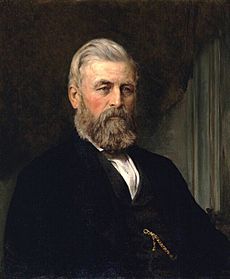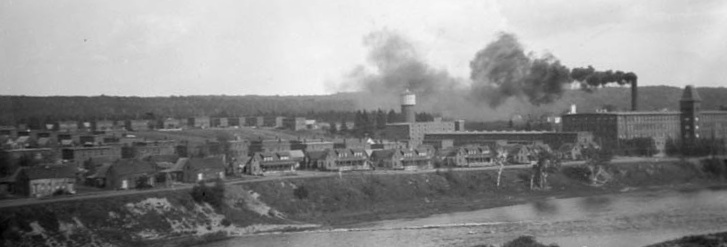Marysville Cotton Mill facts for kids
Quick facts for kids Marysville Place |
|
|---|---|
 |
|
| Former names | Marysville Cotton Mill |
| General information | |
| Type | Cotton mill |
| Town or city | Marysville, New Brunswick |
| Country | Canada |
| Coordinates | 45°58′42″N 66°35′20″W / 45.97833°N 66.58889°W |
| Construction started | 1883 |
| Completed | 1885 |
| Owner | Government of New Brunswick |
| Design and construction | |
| Architecture firm | Lockwood, Greene and Company Mill Architects and Engineers |
The Marysville Cotton Mill, now known as Marysville Place, is a large factory building in Marysville, New Brunswick. It is recognized as a National Historic Site of Canada, meaning it's an important place in Canadian history.
A businessman named Alexander Gibson built the mill in the mid-1880s. He was expanding his businesses into making textiles (like cloth) in the special town he created for his workers. Since 1986, the building has been used by the Government of New Brunswick as an office building. It used to house a large computer data center for government departments.
Contents
The Story of Marysville Place
Alexander Gibson and His Vision
Alexander Gibson moved to the area now called Marysville in late 1862. He bought a large property for £7,300. This property included a gristmill (for grinding grain), a blacksmith shop, a general store, and sawmills (for cutting wood). It also had houses for workers and a huge area of woodland.
His sawmill used the Nashwaak River. Gibson had bought the rights to float logs and rafts down the river to where it met the Saint John River. He built dams to control the river's water flow. This made sure he could move logs all year long.
Building a Town and a Railway
The government offered land grants for building railway tracks. Gibson used this to fund a narrow-gauge railway line to Chatham. He received a very large land grant for this railway. Later, he sold the railway for $800,000.
When Gibson first bought the property, it was not very healthy. The buildings were dirty, and many people got sick with typhoid fever. He cleaned up the area and used the money from the railway sale to build a model village called Marysville. This town was designed to house his workers and their families.
The workers' houses were on the east side of the river, near the cotton mill. Gibson and his managers lived in bigger houses on hills on the west side. A footbridge connected the 24 "White Row" houses (which were duplexes) to the mills. Gibson even started a brickyard to make bricks for the cotton mill and other buildings in the new town.
The Cotton Mill Itself

Construction of the Marysville Cotton Mill began in 1883 and finished in 1885. Its design was inspired by mills in New England. It had a brick foundation with strong piers. The building was designed by A. H. Kelsey, an architect from Lockwood and Greene, a company in Providence, Rhode Island.
The Marysville Cotton Mill was one of the largest mills in The Maritimes. It was also quite isolated. The company built a church and a school for the town. They also ran a company store. Bills from the store and rent for housing were taken directly from the employees' pay.
Workers were paid once a month. The company housing and the need for whole families to work made employees very dependent on Gibson. This discouraged them from quitting suddenly. However, employees were given land for kitchen gardens and for animals to pasture. They also received free firewood.
Alexander Gibson was well-respected by his employees. They made up most of the town's population. A steam whistle from the factory woke workers up in the morning. It also signaled when their ten-hour workday was over.
What the Building Looks Like
The Marysville Cotton Mill is a big brick building. It sits on the east bank of the Nashwaak River. You can find it where Bridge Street and Rue McGloin meet. Marysville is now the most northern part of Fredericton, as it joined the city in 1973.
Each floor of the building has many identical windows with multiple panes. The building has four stories and is about 127 meters (418 feet) long and 30 meters (100 feet) wide. It was the first building in Fredericton to have electric lighting. It also had a sprinkler system to help prevent fires. Most of the building materials came from the local area. Only the strong southern hard pine for the posts and beams was brought from elsewhere.
A National Historic Site
The Marysville Cotton Mill was named a National Historic Site of Canada on June 16, 1986. This means it's a very important place in Canadian history. Later, on November 20, 1993, the whole neighborhood of Marysville was declared a national historic district.
On June 8, 2007, Alexander Gibson himself was recognized as a Person of National Historic Significance. The old railway line that Gibson built has now been turned into a hiking trail for everyone to enjoy.
How It's Used Today
The mill made textiles until it closed in the 1970s. In 1985, the Government of New Brunswick started a project to fix up the building. When it was finished, the first group to move in was the Department of Tourism, Recreation and Heritage.
Today, the Government of New Brunswick uses the building as an office space. It is now called Marysville Place. Until 2016, it was home to the Marysville Data Centre. This was a large data centre used by many government departments. These included the Department of Finance and the Department of Health. Other departments like Justice, Public Safety, and Social Development also used it. Since 2016, it has been used as an office building for various government departments.



